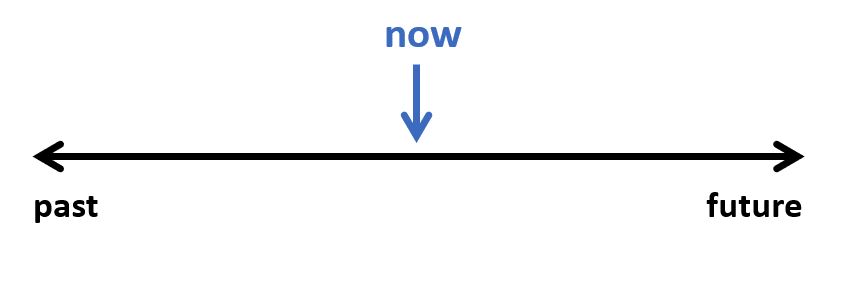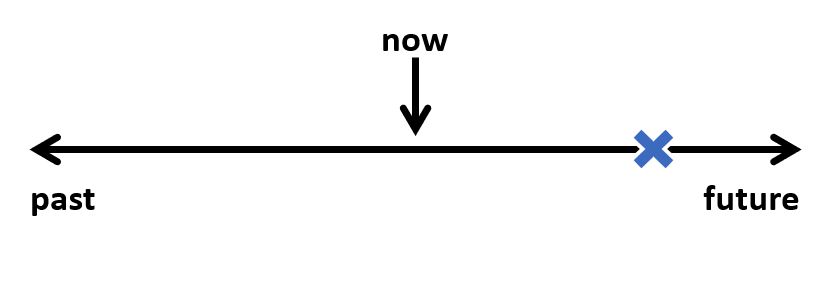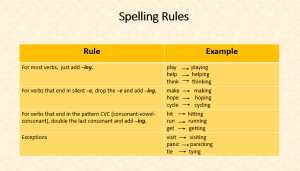3. The Present Continuous Tense
Learning Outcomes
After completing Chapter 3, students will know how to:
- use the functions of the Present Continuous Tense.
- form the Present Continuous Tense in affirmative statements, negative statements and questions.
- apply the Present Continuous Tense in various situations.
- use the correct spelling rules for 3rd person singular verbs in the Present Continuous Tense.
- compare the Simple Present Tense with the Present Continuous Tense.
Functions of The Present Continuous Tense
The Present Continuous is used for:
- actions happening at the present moment.
- temporary actions continuing over a period of time.
- complaints
- informal personal plans for the future
Let us discuss these points in detail.
Actions Happening at the Present Moment:

Actions that are happening at the present moment are activities occurring at the time of speaking. Some examples are:
- I am cleaning my house at the moment.
- He is watching tv in the living room.
- They are studying at school.
- She isn’t helping at work today.
- We aren’t listening to you.
- Are you sitting here?
- What are you doing right now?
Temporary Actions Continuing over a Period of Time:

These are temporary actions that continue over a period of time. The actions started in the past and are still happening in the current time. The actions will probably finish in the future but they are not finished yet. The action might not be happening at the moment of speaking. Some examples are:
- I am taking English classes.
- He is building a new house.
- She is writing a book.
- Are you looking for a job?
Complaints:

This function is commonly used with the adverb “always” or “constantly” to describe ongoing dissatisfaction about a situation that happens repeatedly. Some examples are:
- My teacher is always giving us homework.
- My students are always coming late to class.
- My son is always leaving his dirty socks on the floor.
Plans for the Future:

These actions are for personal plans and arrangements for the future. Some examples are:
- I am playing tennis next Saturday.
- Petro is having a party on the weekend.
- Katie and Roman aren’t going on a honeymoon. They are saving for a house instead.
- Are you travelling to Europe next summer?
Time Markers for The Present Continuous Tense
Some common time markers for The Present Continuous Tense are:
- right now
- now
- at the moment
Form of The Present Continuous Tense
Let us now explore how the Present Continuous Tense is formed:
| Subject + | + “be” | +verb + ing. |
|---|---|---|
| I | am | cleaning. |
| Mohamed | is | studying. |
| Nebrass | is | smoking. |
| The Level 7 students | are | presenting. |
| Subject + | “be” + | not | + verb + ing. |
|---|---|---|---|
| I | am | not | studying. |
| Janice | is | not* | cooking. |
| Pete and Kim | are | not** | dating. |
| You | are | not | studying. |
*is not = isn’t **are not = aren’t
| “Be” + | subject | + verb + ing? | Short Answer |
|---|---|---|---|
| Am | I | studying? | Yes, you are./No, you aren’t. |
| Is | Ryan | playing? | Yes, he is./No, he isn’t. |
| Are | you | cheating? | Yes, I am./No, I’m not. |
| Wh ? + | “be” | + subject | verb + ing | Answer |
|---|---|---|---|---|
| What | am | I | doing? | You are listening to a podcast. |
| Where | is | Jenne | studying? | She is studying at Georgian College. |
| When | are | you | leaving? | I am leaving after lunch. |

Present Continuous Functions & Form Review
Watch this interactive video to review the forms and functions of Present Continuous. Be ready to pause and play the video, and complete the activities!
Present Continuous Functions & Examples (Text Version)
Watch the video The Present Continuous Tense (6:30 min)
- Pause at 0:15: What is the contraction of “I am” in the sentence “I am sleeping”?
- Pause at 0:18: What’s the contraction of “you are” in the sentence “You are sleeping”?
- Pause at 0:22: What is the contraction of “he is” in the sentence “He is sleeping”?
- Pause at 0:25: What is the contraction of “we are” in the sentence “We are sleeping”?
- Pause at 0:30: For the negative, what is the contraction of “I am not” in the sentence “I am not sleeping”?
- Pause at 0:33: What is the contraction of “you are not” in the sentence “You are not sleeping”?
- Pause at 0:39: What is the contraction of “she is not” in the sentence “She is not sleeping”?
- Pause at 0:44: What is the contraction of “they are not” in the sentence “They are not sleeping”?
- Pause at 1:03: Put the following words and punctuation in the correct order to make a question:
- house
- are
- coming
- they
- our
- to
- ?
- Pause at 1:13: Multiple choice question: Are you having fun?
- Yes, I am.
- No, I’m not.
- Yes, I am having fun.
Pause at 1:34-1:38: Remember: these are actions that can be seen and they are happening now. They are not stative verbs.
Pause at 2:05-2:12: Notice these actions are temporary and not permanent. They are happening around now, but have not finished yet and are expected to end.
- Pause at 4:27: Which sentences shows something you don’t like, or is irritating or annoying?
- She is always sending long texts.
- She always sends long texts.
- Pause at 5:17: Which sentence shows something that happens a lot but I’m not angry about it?
- He always talks in class.
- He is always talking in.
- Pause at 5:24: Put these words in order to make a complete accurate sentence:
- at
- currently
- sleeping
- in
- she
- the
- her
- moment
- is
- room
The summary below reviews what we’ve learned in the video:
I can use the present continuous to show:
- an action is happening right now at the time of speaking;
- an action is happening in my life around the time of speaking, it is a longer action in progress, it is temporary, and the action hasn’t finished yet;
- a future action that is planned and arranged;
- and an action that happens repeatedly or all the time and it is annoying, irritating, and I don’t like it.
Check your Answer in footnote[1]
Activity source: “Present Continuous Form and Function Interactive Video” by Sari Martin, licensed under CC BY-NC SA 4.0. Video Source: Smrt English. The present continuous tense [Video]. YouTube. https://youtu.be/W1xJ4bk1pGc
Present Continuous Functions Practice
Present Continuous Functions (Text Version)
Guess the function of each present continuous sentence. The functions are: actions happening at the present moment; temporary actions happening over time around now; complaints about repeated actions; future plans.
- They are leaving for Thailand in 2 months.
- He’s always leaving dishes in the sink.
- A: Long time no see! What’s new? B: Well, I’m reading a great new book.
- I can’t talk on the phone right now. I’m studying for a test.
- It’s 6:00pm and I’m cooking dinner.
- I’m meeting with my friends for dinner tonight.
- She’s always losing her keys.
- The dog is always playing in mud.
- I’m working at a car dealership for my placement program this summer.
- I’m looking out the window and watching a squirrel feed her babies in the tree.
- Do you like what I’m wearing?
- Do you like my dress? I’m going on a date soon.
Check your Answers in footnote[2]
Activity source: “Present Continuous Functions” by Sari Martin, licensed under CC BY-NC SA 4.0.
Present Continuous Form Practice – Affirmative
Try the interactive activity below to practice the form of Present Continuous. Fill in the blanks, and click ‘Check’ to check your answers.
Present Continuous (Text version)
Fill in the missing words. Complete the following sentences using present continuous form of verbs given in the bracket, (formed by adding ‘ing’ to the base verb, along with a helping verb).
- Sunita ________[Blank 1 – go] to the movie with her mother.
- Sheela ________[Blank 1 – walk] to school this morning,
- The boys ________[Blank 1 – play] football in the park.
- Please turn off the TV. I ________[Blank 1 – do] my homework.
- My mother ________[Blank 1 – make] pizza today.
- Anita ________[Blank 1 – laugh] at the funny clown in the circus.
- Astrid ________[Blank 1 – eat] a sandwich for breakfast.
- All girls ________[Blank 1 – wear] pink dresses today.
- Raj ______________[Blank 1 – hide] something under the bed.
- Dunja ________[Blank 1 – walk] towards the bus stop to board her school bus.
Check your answers: [3]
Activity source: “Present Continuous” by Annapurna Madhuri, edited by Sari Martin, from “3 – Simple Present and Present Continuous” In Effective English for Teachers by Annapurna Madhuri, licensed under CC BY-NC SA 4.0. / Activity title, names and instructions changed, converted to text.
Present Continuous Form Practice – Negative
Rewrite in negative form (Text Version)
Rewrite in negative form:
Eg. The children are watching TV now.
Answer: The child is not watching TV now.
- Jay is having breakfast now.
- Stefan is answering the call at the moment.
- I am helping Melodie with her work today.
- The boys are washing dishes.
- The student is sleeping in the class.
- It is raining heavily now.
- The students are writing an essay.
- You are doing this exercise correctly.
- The dog is drinking milk.
Check your answers: [4]
Activity source: “Rewrite in negative form” by Annapurna Madhuri, edited by Sari Martin, from “3 -Simple Present and Present Continuous” In Effective English for Teachers by Annapurna Madhuri, licensed under CC BY-NC SA 4.0. / Converted to text and minor edits.
Present Continuous Form Practice – Interrogative
Present Continuous Interrogative Form (Text version)
Rewrite the sentences in interrogative form.
Eg. The children are watching TV now.
Answer: Are the children watching TV now?
- Jay is having breakfast now.
- Stefan is answering the call at the moment.
- I am helping Melodie with her work today.
- The boys are washing dishes.
- The student is sleeping in the class.
- It is raining heavily now.
- The students are writing an essay.
- You are doing this exercise correctly.
- The dog is drinking milk.
Check your Answers in footnote: [5]
Activity source: “Present Continuous Interrogative Form” by Annapurna Madhuri, edited by Sari Martin, from “3 – Simple Present and Present Continuous” In Effective English for Teachers by Annapurna Madhuri, licensed under CC BY-NC SA 4.0. / Converted to text and minor edits.
Focus on Time Markers
We now know that present continuous tense is used to describe actions in the situations discussed in the picture below.
Time Markers or Signal words for present continuous tense:
- Actions happening at the time of speaking:
- at the moment, now, just now. right now, listen.., look..
- Actions going on now:
- at the moment, now
- Actions depicting current trend/taking place for a given time period/temporary situation:
- this week/this month/this year
- Actions planned in the near future:
- in the morning/afternoon/evening, at noon/night, tonight, tomorrow, next week/month/year/session
Present Continuous Signal Words and Form Practice (Text version)
Use the suitable form of verbs given in the brackets, to complete the sentences, taking hints from signal words:
- My brother, Ivan, ________[Blank 1 – stay] in California at present.
- Mr. Kim ________[Blank 1 – watch ] IPL on TV at the moment
- For the time being, Maria ________[Blank 1 – work] as a principal.
- Listen! Somebody ________[Blank 1 – play] rock music on the street.
- Look at that man! He ________[Blank 1 – wear] a uniform. He must be a police officer.
- Right now, I ________[Blank 1 – sit] at my desk in class.
- They ________[Blank 1 – watch] TV now.
Check your Answers in footnote: [6]
Activity source: “Present Continuous Signal Words and Form Practice” by Annapurna Madhuri, edited by Sari Martin, from “3 – Simple Present and Present Continuous” In Effective English for Teachers by Annapurna Madhuri, licensed under CC BY-NC SA 4.0. / Converted to Text and minor edits.
Pair Work or Small Groups
Ask and answer the following questions in partners or a small group:
- What are you doing right now?
- What are the other students in your class doing?
- Where are you sitting?
- Who are you talking to?
- What is the teacher doing?
- Who is using their phone in the class?
- Who is wearing glasses?
- Why are you taking English classes?
- What are you doing on the weekend? (plans for the future)
Communicative Activity – Live Report
-
Students go to different areas of the college and look around. Write 5 sentences about what people are doing.
-
“In the library, a lone student is reading in the corner.”
-
“Two students in the cafeteria are buying pizza.”
-
-
Share in pairs or with the whole class.

Verb Tenses in Music
For a fun activity, listen to the following songs:
- Tom’s Diner by Suzanne Vega
- Lemon Tree by Fool’s Garden
Can you hear the Present Continuous Tense in the lyrics?

Attribution & References
Except where otherwise noted, “The Present Continuous Tense” by Sari Martin & Virginia McHardy is licensed under CC BY-NC-SA 4.0.
-
- I'm sleeping
- You're sleeping.
- He's sleeping.
- We're sleeping.
- I'm not sleeping.
- You aren't sleeping.
- She isn't sleeping.
- They aren't sleeping.
- Are they coming to our house?
- a) Yes, I am.
- a) She is always sending long texts.
- a) He always talks in class.
- She is currently sleeping in her room at the moment.
-
- future plans
- a complaint about a repeated action
- a temporary action happening over time around now
- an action happening at the moment
- an action happening at the moment
- future plans
- a complaint about a repeated action
- a complaint about a repeated action
- a temporary action happening over time around now
- an action happening at the moment
- an action happening at the moment
- future plans
-
- is going
- is walking
- are playing
- am doing
- is making
- is laughing
- is eating
- are wearing
- is hiding
- is walking
-
- Jay is not having breakfast now.
- Stefan is not answering the call at the moment.
- I am not helping Melodie with her work today.
- The boys are not washing the dishes.
- The student is not sleeping in the class.
- It is not raining heavily now.
- The students are not writing an essay.
- You are not doing the exercise correctly.
- The dog is not drinking milk.
-
- Is Jay having breakfast now?
- Is Stefan answering the call at the moment?
- Am I helping Melodie with her work today?
- Are the boys washing dishes?
- Is the student sleeping in the class?
- Is it raining heavily now?
- Are the students writing an essay?
- Are you doing the exercise correctly?
- Is the dog drinking milk?
-
- is staying
- is watching
- is working
- is playing
- is wearing
- am sitting
- are watching

